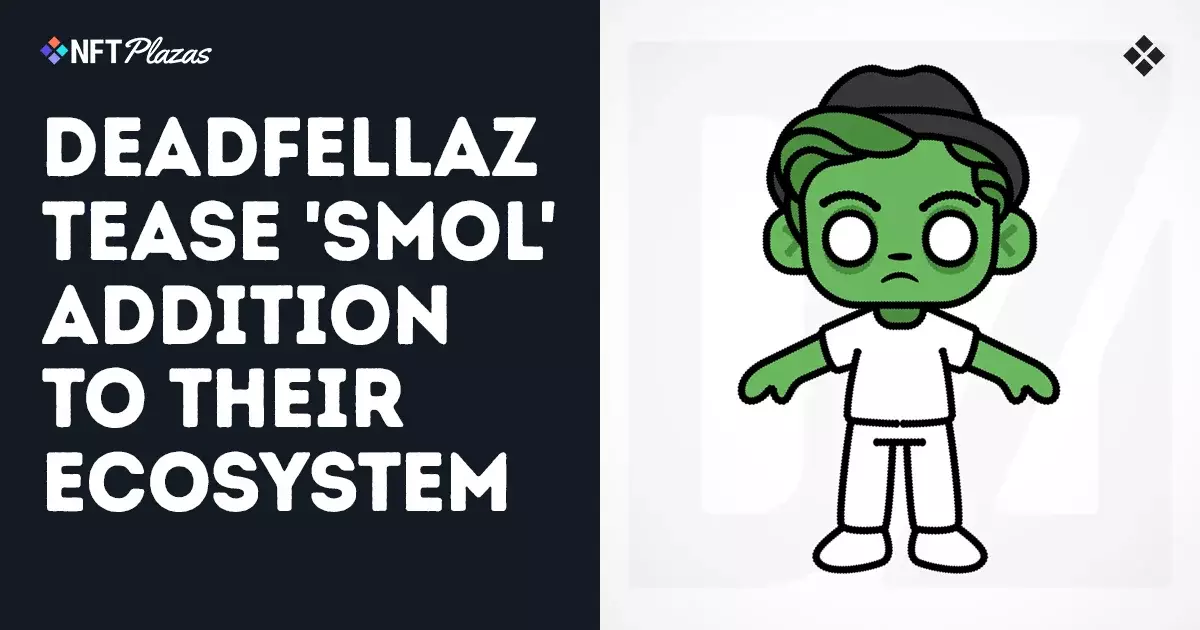The NFT market has long been a two-edged sword, slicing through traditional paradigms of ownership while also breeding skepticism among investors and players alike. Enter Deadfellaz, a trailblazer in the zombie-themed NFT realm, whose recent announcements hint at yet another potential cash grab masked as innovation. The anticipation around the “smol” addition to their ecosystem cannot be overlooked, as it comes at a time when the market is tenuously balancing on the edge of sustainment. Given their history of monumental announcements, one can’t help but wonder if this new project will be a standalone marvel or just another reiteration of past successes.
In recent weeks, stakeholders have been buzzing over hints dropped by DFZ Labs director, Psych, who teetered on the edge of excitement and vagueness. While the intrigue surrounding a new customizable avatar addition could invigorate the community, how sustainable is this layer of creativity? The NFT landscape has been rife with projects that oversell and underdeliver, and one has to question whether Deadfellaz can avoid the pitfalls that so many have stumbled through.
Ghost Machine and Coldlink: Echoes of Innovation or Repetitive Gimmicks?
It’s undeniable that Deadfellaz has made strides, with the introduction of tools like Coldlink and art projects like Ghost Machine. However, amid all of this so-called “innovation,” one must eye these moves critically. Coldlink offers an ostensibly clever solution meant to intertwine users’ social media and wallets, but does it genuinely enhance the user experience, or is it just a way to retain interest? The excitement around Ghost Machine, a hyper-pop art collection, was palpable, but the reality of value retention looms large.
Every time an announcement is thrust into the spotlight, it begs a vital question: Are these additions genuinely augmenting the Deadfellaz brand, or are we merely witnessing another round of the NFT hype cycle that is destined to fizzle out? The community’s loyalty is admirable, but it’s essential to see through the marketing curtain that often obscures the sharp, jagged edges of reality.
The Avatar Revolution: A Double-Edged Sword
The latest speculation surrounding the customizable avatar layer, reminiscent of Doodles 2, may seem appealing, but it also opens up a Pandora’s box of potential issues. Are these avatars merely a way to monetize off the individuality of collectors, or could they genuinely enrich the Deadfellaz experience? One can’t dismiss the fact that the allure of customization is often overly romanticized in similar environments.
Should the Deadfellaz team succeed in crafting a system that allows for true personalization and meaningful utility, it could yield a flourishing community. Alternatively, if these avatars become glorified skins that don’t expand upon actual gameplay or interactivity, then we’re looking at an industry that increasingly thrives on illusion rather than substantive evolution.
Market Viability: Has Deadfellaz Become Just Another Overhyped Commodity?
It’s easy to get swept up in the excitement of the NFT renaissance, especially when projects like Deadfellaz have established their presence. But a critical eye observes the fluctuating values, not just of one collection, but of the entire NFT market. The early adopter sentiment has dwindled, and with major players like Deadfellaz still calling the shots, it’s worth scrutinizing whether they offer genuine value or simply perpetuate an environment hanging by a thread.
It’s crucial to separate the wheat from the chaff; while Deadfellaz offers an attractive aesthetic and community environment, can they maintain relevance in a time when the waters are murky with uncertainty? If the next phases don’t break from the cycles of repetitiveness, we risk seeing yet another chapter in the grimmer story of NFT market follies and unrealized potential fading into obscurity.
Bleak as this may seem, the very conversations about sustainability bring forth the potential for transformation. Whether Deadfellaz can capitalize on this moment remains to be seen, but the question still looms: Are they riding the wave of innovation, or merely kicking the can down the road?

